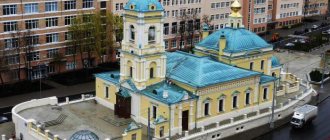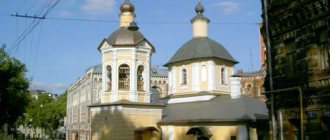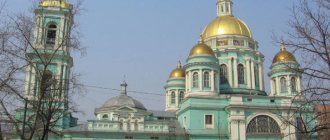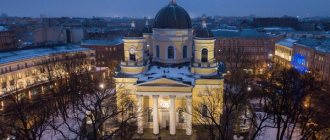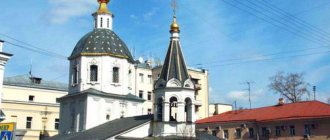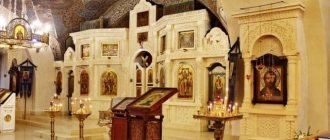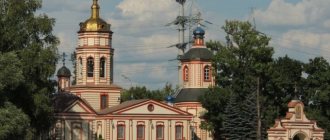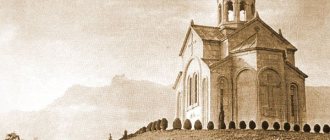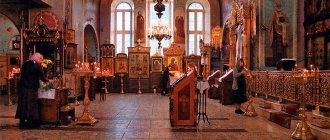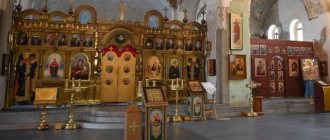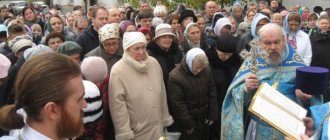The author of the project for the new Transfiguration Church in the village of Spas-Tushino was the architect of the Chamber of State Property Vladislav Osipovich Grudzinsky. Soon after the project was approved, in 1875, the brick refectory and bell tower of the old church were dismantled to the ground, and the bricks were used to build a fence around the new church. Metropolitan Ioannikiy of Moscow and Kolomna personally consecrated the Spaso-Tushino Church on the day of the Transfiguration of the Lord, August 6, 1886.
By 1917, the village of Spas-Tushino had become a large industrial center of the textile industry. After the revolution, church lands were nationalized. In the 30s In the 20th century, Tushino became a major industrial center: heavy industrial enterprises were built there and an airfield was opened. In 1935, the Transfiguration Church was closed, the last rector Alexander Sokolov was repressed as an “enemy of the people”, the previous one, priest Alexander Buravtsev, was shot at the Butovo training ground in 1937.
In the 1950s The bell tower was blown up and the dome was demolished, the church housed a club, then a warehouse and workshops, the surrounding area was turned into a landfill.
In 1990, the temple was returned to the Russian Orthodox Church. Worship resumed in August 1990; the temple became the first in Moscow consecrated by His Holiness Patriarch Alexy II after his enthronement. The bell tower of the temple was restored in 1994.
Currently, the interior of the main temple is decorated with mosaics (works by artists A.D. Kornoukhov, D.M. and I.D. Shakhovsky, L.D. Kurilo, L.D. Tsarev), the refectory part of the temple was painted by artists V.A. . Sidelnikov and V.I. Lyubarsky. The restored temple is made of brick from the outside. Three iconostases in the ancient Russian style were made by the artist O.G. Klodt. By 1999, the temple was completely restored. The revival of church life and restoration was headed by Archpriest. Feodor Sokolov (1959-02/21/2000), buried at the altar of the temple.
Modernity
The building was transferred to the Orthodox Church in 1990. In August of the same year, the Church of the Transfiguration of the Lord in Tushino was consecrated by Patriarch Alexy II. Over the next four years, the chapels of St. Nicholas the Wonderworker, St. Sergius of Radonezh and the bell tower were restored and consecrated.
To date, there is a cemetery on the temple grounds, where the remains of people from the graveyard destroyed during the Soviet years and a Sunday school building have been reburied.
The temple servants are active in educational and social activities.
Story
The village of Spasskoye and the village of Tushino, located nearby on an elevated plateau on the left bank of the Vskhodnya River, have been known since the end of the 14th century, when they belonged to the boyar Rodion Nesterovich Kvashnya.
In ancient times, in the village of Tushino there was a Church of the Nativity of the Virgin Mary, which was abolished in the 18th century and then dismantled. In the village of Spassky, from the 14th century until 1764, the Spaso-Preobrazhensky Monastery was located, transferred by the descendants of Vasily Ivanovich Kvashnin, nicknamed “Tusha,” into the possession of the Trinity-Sergius Lavra. The first church of the monastery was the Church of the Transfiguration - first wooden, and then stone, which, due to its dilapidation, was dismantled around the middle of the 17th century. The second church of the monastery is a single-altar, stone, hipped church in the name of St. martyr Andrew Stratilata was built in the 16th century. The Monastery of the Savior on Vkhodnya flourished, but the period of False Dmitry II began. He settled down with his army near the village of Tushino and the Spassky Monastery in 1608, not daring to storm Moscow. This army was called the “army of the Tushino thief”, since food was obtained by robbery. Having devastated the villages and ruined the monastery, the “thieves” were expelled, leaving the walls of the Transfiguration Church destroyed.
After the abolition of the monastery in 1764, the tent-roofed Transfiguration Church became the parish church of the villages of Spasskoye and Tushino. A wooden refectory was built with her, which was dismantled in 1804-1808, and a new, more spacious stone refectory was built in its place. A stone multi-tiered bell tower was also added to the refectory on the western side. In 1849, the refectory was somewhat rebuilt, setting up an altar and placing a chapel in it in the name of St. Sergius of Radonezh.
The large size of the parish required larger church premises, so the question of expansion or reconstruction inevitably arose. The parishioners were also worried about the dilapidation of the ancient church and the danger of its collapse along with the sliding of the river bank, on the very edge of which it found itself after three centuries from its foundation. At the end of 1870, a decision was made to build a new stone church in the village of Spassky - away from the first one and away from the dangerous cliff of the bank - at the opposite end of the main street of the village of Spassky and closest to the village of Tushino.
The author of the project for the new Transfiguration Church in the village of Spas-Tushino was the architect of the Chamber of State Property Vladislav Osipovich Grudzinsky. Soon after the project was approved, in 1875, the brick refectory and bell tower of the old church were dismantled to the ground, and the brick was used to build a fence around the new church. Metropolitan Ioannikiy of Moscow and Kolomna personally consecrated the Spaso-Tushino Church on the day of the Feast of the Transfiguration, August 6, 1886. There were 6 bells hanging on the bell tower: the big one was cast in 1821, the rest during the construction of the temple. There was no painting inside the temple.
By 1917, the village of Spas-Tushino had become a large industrial center of the textile industry. The factory settlement grew, agriculture faded into the background. Changes in the life of the village also affected the church: its land was nationalized. In 1930, Tushino became a major industrial center - heavy industry enterprises were built, and an airfield was opened. After Sergius Buravtsev, his son Alexander Buravtsev became a priest, and after him Alexander Sokolov became the rector of the temple. In 1935, the temple was closed and desecrated. The last serving priests were repressed and shot in 1937. Alexander Buravtsev was shot and buried in Butovo. The place of execution and burial of Alexander Sokolov is being clarified; he was rehabilitated in 1989.
The church in Spas-Tushino was used as a club for a number of years. In 1956, the authorities responded to the request of local residents to transfer the temple to believers by exploding the bell tower. At the same time, the main dome was demolished. The last tenant of the temple, the repair and construction department, turned the area around it into a landfill, and the church was divided into many cells.
In 1990, parish life was resumed in Tushino. On June 11, a memorial service was served in the courtyard on the fortieth day of the death of the Patriarch of Moscow and All Rus' Pimen, a prayer service before the icon of the Mother of God “Joy of All Who Sorrow,” which was found on the street. On August 17, on the eve of the Feast of the Transfiguration of the Lord, Patriarch Alexy II of Moscow and All Rus' consecrated the temple and its main altar (the first temple in Moscow consecrated by him after his elevation to the patriarchal rank). On December 17, 1991, iconostases already stood within the boundaries, and a unique mosaic composition was created in the central area.
A Sunday school and singing courses were opened at the church, work was carried out with prisoners, and a strong connection was established with the army.
Currently, the church continues to operate a Sunday school, singing courses, and a prison liaison group.
There is a charity group in the parish. The area of activity of the charity group is very diverse: street children, teenagers, large families, disabled people, the elderly.
The shrine is the myrrh-streaming Life-Giving Cross of the Lord.
The house temple of the icon of the Mother of God “Support of Sinners” at the Krasnopresnenskaya transit prison is assigned.
Architecture and interior
Modern restorers have recreated the appearance of the building using old photographs and the remains of surviving architectural elements. The temple building is made of red brick. It has a rectangular shape, elongated from west to east. The main part is crowned with a black onion-shaped head standing on a round drum. It is balanced by the bulbous top of the temple bell tower. The northern and southern aisles of the church are crowned with small gilded heads.
The facades and rounded apse are decorated with mosaic images of the apostles and holy fathers of the church. The icon cases depict the composition “Deesis”.
Interior of the Church of the Transfiguration of the Lord in Tushino
Inside, the walls and columns of the main part of the church are decorated with mosaics made by a group of craftsmen under the leadership of L. D. Tsarev. The large and two small iconostases were made in the ancient Russian manner and painted by icon painter Olga Grigorievna Klodt. The walls of the refectory and both aisles are covered with paintings.
The restrained architecture of the temple is complemented by a beautiful garden, laid out by the priests and parishioners.
Church of the Transfiguration Tushino schedule of services
Troparion of Blessed Xenia of St. Petersburg
Poverty? Love the lice, / the immortal table? We do not enjoy, / the madness of the imaginary madness of the world, having exposed the lice, / the humility of the cross to the power of Bo? did you perceive life?./ This? For the sake of the gift of miraculous help, you have acquired, / Blessed Xenia, pray? Christ? God // we can be delivered from all evil by repentance.
Translation: Having loved the poverty of Christ, now you enjoy the Immortal Table, having exposed the madness of the world with your imaginary madness, by humility on the cross you have accepted the power of God. Therefore, blessed Xenia, who has deserved the gift of miraculous help, pray to Christ God for our deliverance from all evil through repentance.
BRIEF LIFE OF BLESSED XENIA OF PETERSBURG
Blessed Xenia was born between 1719 and 1730. Nothing is known about her parents, about her childhood and adolescence. We know that the blessed one’s father’s name was Gregory.
Upon reaching adulthood, Ksenia married the court singer Andrei Fedorovich Petrov, who held the rank of colonel. But the young couple was not destined to enjoy family happiness for long: twenty-six years old, Ksenia remained a widow. Her husband died suddenly.
This tragic event changed the life of a young woman. She was deeply shocked that her husband died without proper Christian preparation and did not have time to repent. Ksenia decided that with the feat of life she would beg God for forgiveness of the sins of God's servant Andrei.
On the day of her husband’s funeral, Ksenia Grigorievna put on his clothes and told everyone who approached her with condolences that it was not Andrei Fedorovich who died, but his wife Ksenia Grigorievna. From that moment on, she truly died for the world, having taken upon herself the most difficult feat - the feat of foolishness for Christ's sake.
Her relatives and friends believed that the young widow had lost her mind due to the grief that had fallen on her shoulders. Their suspicions were finally confirmed when Ksenia decided to distribute the property she inherited from her husband. So, she donated her house, which was located in the parish of the Church of St. ap. Matthew on the St. Petersburg side, to his friend Paraskeva Antonova. She did not want to accept this gift and even asked Ksenia’s relatives on her husband’s side to protect her from such an act. Relatives turned to the superiors of the late Petrov, influential people talked with the widow, found her in perfect sanity and decided that she was quite capable of managing her property.
From now on she had no permanent place of residence. During the day she wandered around the city, mainly along the Petersburg side, near the church of St. Matthew, and at night she went out of town, into the field - and prayed all night. So one day she was found by townspeople who became interested in the nightly disappearances of the blessed one. She rarely stayed overnight in the houses of pious women she knew.
Blessed Ksenia with extraordinary meekness endured all the mockery and insults that she often had to endure. She was especially bothered by street boys, whose evil antics she paid no attention to. Only once, when the residents had already begun to reverence her as a saint of God, did they happen to see the blessed one in terrible anger. The insolent brats were not content with the usual insults, but began throwing clods of earth at Ksenia. After this incident, the townspeople began to protect blessed Xenia and put an end to the persecution by the boys.
When Andrei Fedorovich's costume decayed and fell apart, the saint dressed herself in rags. When she was offered clothes in the form of alms, she refused. She only took a red blouse and a green skirt (or vice versa). Probably in memory of the colors of my husband's uniform. She also avoided taking monetary alms. She only accepted the “king on horseback” - copper pennies, which she immediately distributed to the poor.
During these years, a new stone church was built at the Smolensk cemetery in the name of the Smolensk Icon of the Mother of God. The workers working on the construction of the temple suddenly began to notice strange things. During their absence, at night someone carried bricks onto the scaffolding of the church under construction. And when they decided to find out who this voluntary helper was, they saw that it was blessed Ksenia working at night, dragging bricks onto the scaffolding.
For her great deeds, the Lord honored Blessed Xenia with the gift of clairvoyance. Thus, she predicted the time of death of Empress Elisaveta Petrovna and the young Emperor Ivan Antonovich, and helped one girl avoid marriage with a runaway convict posing as the colonel he had killed. Residents of the St. Petersburg side noticed that if the blessed one took a sick child in her arms or blessed him, he would certainly recover. If he takes some small change from a merchant’s shop, the trade will be successful. If she enters the house, then peace and harmony will reign in the house.
One day she told her old friend Paraskeva Antonova, the same one to whom she gave the house, to immediately go to the Smolensk cemetery: “You’re sitting here darning your stockings, but you don’t know that God sent you a son!”
Paraskeva walked towards the cemetery in bewilderment and suddenly saw a crowd of people. It turned out that the crew had crushed to death a pregnant woman who had given birth to a boy before her death. Paraskeva took him for herself, and since she could not find the baby’s father anywhere, she adopted him. The adopted son raised by her revered her as a mother and in her old age protected the peace of Paraskeva, who thanked the blessed one for her great joy.
Blessed Xenia carried out the feat of voluntary madness for 45 years and died around 1803. Over time, a stone chapel was erected on her grave (at the Smolensk cemetery), which to this day serves as one of the shrines of St. Petersburg, attracting numerous pilgrims.
After many years of popular veneration, Blessed Xenia of St. Petersburg, a fool for Christ's sake, was canonized in 1988 at the Local Council of the Russian Orthodox Church.
Work schedule
Services are held daily.
- on weekdays they hold morning and evening services, which begin at 8 and 17 o'clock, respectively;
- on weekends and days of general church and patronal holidays (Transfiguration of the Lord on August 19, St. Nicholas the Wonderworker on May 22 and December 19, St. Sergius of Radonezh on July 18 and October 8), two morning services are held at 7 and 9.40 am.
Divine Liturgy at the Church of the Transfiguration of the Lord
Sunday School classes are held on Saturdays from 10 a.m. to 2 p.m. and Sundays from 12.30 p.m. to 6 p.m.
The schedule of services at the Church of the Transfiguration of the Lord in Tushino, as well as classes at the Sunday School, the work of the library and various associations is specified on its official website.
You should know: the church website contains rules of conduct when visiting a holy place. You should familiarize yourself with them before coming to the temple. Taking photographs and filming videos on the premises is only possible with the permission of the abbot. Therefore, people who just want to take pictures of beautiful architectural structures are better off doing this from behind the church fence.
Church of the Transfiguration of the Lord in Tushino
Contact details
Address: 125371, Moscow, Volokolamskoe highway, 128.
Telephone: +7 (495) 491-9103
Schedule of services: - daily: 17-00 - Evening service. - Monday to Saturday: 8-00 - Divine Liturgy. - on Saturdays: after the Liturgy, a funeral litany is celebrated at the grave of Archpriest. Feodora Sokolov. - Sundays and holidays: 07-00 and 09-40 - Divine Liturgy. — on Sundays: 15-00 — akathist to St. blgv. Peter and Fevronia of Murom, 17-00 - Vespers with an akathist to the Savior, Mother of God, holy. Nicholas the Wonderworker and St. Sergius of Radonezh - alternately.
Clergy
Rector: His Eminence Mercury, Metropolitan of Rostov and Novocherkassk
Clerics:
Archpriest Vasily Vorontsov priest Dimitry Evmenov priest Arseny Ulanov priest Anthony Novikov priest Mikhail Klimov deacon Sergius Andreev deacon Andrey Zubkov
Temple on the map
About the temple
Patronal holidays
— The main holiday is the Transfiguration of the Lord (August 19); — St. Nicholas of Myra (December 19); - Rev. Sergius of Radonezh (October 8).
The temple was built according to the design of the architect V. O. Grudzin in 1880, with significant donations from the priest John Spassky, manufacturers V. N. Suvirov and K. E. Prokhorov, as well as state councilor P. G. Tsurikov. Consecrated on August 6, 1886 (old style) on the day of the Feast of the Transfiguration of the Lord by Metropolitan Ioannikiy of Moscow and Kolomna.
In 1935, the temple was closed and desecrated. The rectors of the temple: the penultimate one, priest Alexander Buravtsev, and the last one, priest Alexander Sokolov, were arrested and shot.
In August 2000, the Jubilee Council of Bishops canonized priest Alexander Buravtsev, who was shot on December 22, 1937 at the Butovo training ground, as one of the holy new martyrs and confessors of Russia.
In 1990, through the efforts of Rev. Theodore Sokolov and a group of believers returned the temple to the Russian Orthodox Church. His active recovery began. On August 17, 1990, His Holiness Patriarch of Moscow and All Rus' ALEXIY II consecrated the temple and its main altar. In 1991 and 1993, the chapels of St. Nicholas of Myra and St. Sergius of Radonezh. Since 2000, after the tragic death of Rev. Feodora Sokolov, until 2021 the rector of the temple was Archpriest Vasily Vorontsov.
On July 22, 2012, the temple was visited for the first time by His Holiness Patriarch of Moscow and All Rus' KIRILL, and during the Divine Liturgy he performed the consecration of Archimandrite. Sophrony (Kitaev) as Bishop of Gubkin and Grayvoron.
At the end of 2021, His Holiness Patriarch KIRILL blessed the placement of the Synodal Department for Religious Education and Catechesis in the parish premises. In connection with this, His Eminence MERCURY, Metropolitan of Rostov and Novocherkassk, Chairman of the Department, became the rector of the temple.
